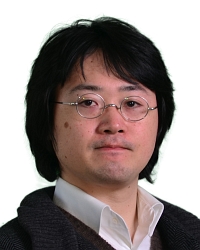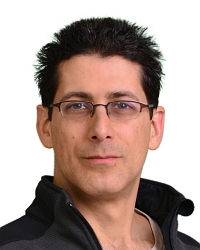Electronic and Photonic Devices
Pursuing theoretical and experimental research for next generation devices.
We explore various device technologies, material science and device architectures to dramatically improve power and RF device performance to achieve higher efficiency, high linearity and much wider frequency band. We develop novel photonic integrated circuits to improve performance and reduce cost in optical communications applications.
Quick Links
-
Researchers
-
Awards
-
AWARD Toshiaki Koike-Akino elected Fellow of Optica Date: November 18, 2021
Awarded to: Toshiaki Koike-Akino
MERL Contact: Toshiaki Koike-Akino
Research Areas: Communications, Electronic and Photonic Devices, Signal ProcessingBrief- Toshiaki Koike-Akino's research activities in communications, error control coding and optical technologies at MERL have earned him election as a Fellow Member of Optica (formerly OSA), the foremost professional association in optics and photonics worldwide. Fellow membership in Optica is limited to no more than ten percent of the membership and is reserved for members who have served with distinction in the advancement of optics and photonics. Koike-Akino is one of 106 members from 24 countries in Optica’s 2022 Fellows Class, elected during the Board of Directors of Optica meeting held on 2nd of November, 2021.
“Congratulations to the 2022 Optica Fellows,” said 2021 President Connie Chang-Hasnain, University of California, Berkeley, USA. “These members exemplify what it means to be a leader in optics and photonics. Your election, by your peers, confirms the important contributions made within our field. Thank you for your dedication to Optica, and for advancing the science of light.”
Koike-Akino's elevation to Fellow is specifically “for outstanding and innovative contributions to R&D in enabling technologies for optical communications, including nonlinear equalizers, high-dimensional modulations, and FEC (Forward Error Correction),” said Meredith Smith, Director, Optica Awards and Honors Office. "Again, congratulations on joining this esteemed group of Optica members."
About Optica
Optica (formerly OSA) is dedicated to promoting the generation, application, archiving and dissemination of knowledge in optics and photonics worldwide. Founded in 1916, it is the leading organization for scientists, engineers, business professionals, students and others interested in the science of light. Optica’s renowned publications, meetings, online resources and in-person activities fuel discoveries, shape real-life applications and accelerate scientific, technical and educational achievement.
- Toshiaki Koike-Akino's research activities in communications, error control coding and optical technologies at MERL have earned him election as a Fellow Member of Optica (formerly OSA), the foremost professional association in optics and photonics worldwide. Fellow membership in Optica is limited to no more than ten percent of the membership and is reserved for members who have served with distinction in the advancement of optics and photonics. Koike-Akino is one of 106 members from 24 countries in Optica’s 2022 Fellows Class, elected during the Board of Directors of Optica meeting held on 2nd of November, 2021.
-
AWARD MERL researchers presented 5 papers at the 2016 Optical Fiber Communication Conference (OFC), including one "Top Scored" paper Date: March 24, 2016
Awarded to: Toshiaki Koike-Akino, Keisuke Kojima, David S. Millar, Kieran Parsons, Tsuyoshi Yoshida, Takashi Sugihara
MERL Contacts: Toshiaki Koike-Akino; Kieran Parsons
Research Areas: Communications, Electronic and Photonic Devices, Signal ProcessingBrief- Five papers from the Optical Comms team were presented at the 2016 Optical Fiber Conference (OFC) held in Anaheim, USA in March 2016. The papers relate to enhanced modulation formats, constellation shaping, chromatic dispersion estimation, low complexity adaptive equalization and coding for coherent optical links. The top-scored paper studied optimal selection of coding and modulation sets to jointly maximize nonlinear tolerance and spectral efficiency.
See All Awards for MERL -
-
News & Events
-
EVENT MERL Contributes to ICASSP 2025 Date: Sunday, April 6, 2025 - Friday, April 11, 2025
Location: Hyderabad, India
MERL Contacts: Wael H. Ali; Petros T. Boufounos; Radu Corcodel; Chiori Hori; Siddarth Jain; Toshiaki Koike-Akino; Jonathan Le Roux; Yanting Ma; Hassan Mansour; Yoshiki Masuyama; Joshua Rapp; Diego Romeres; Anthony Vetro; Pu (Perry) Wang; Gordon Wichern
Research Areas: Artificial Intelligence, Communications, Computational Sensing, Electronic and Photonic Devices, Machine Learning, Robotics, Signal Processing, Speech & AudioBrief- MERL has made numerous contributions to both the organization and technical program of ICASSP 2025, which is being held in Hyderabad, India from April 6-11, 2025.
Sponsorship
MERL is proud to be a Silver Patron of the conference and will participate in the student job fair on Thursday, April 10. Please join this session to learn more about employment opportunities at MERL, including openings for research scientists, post-docs, and interns.
MERL is pleased to be the sponsor of two IEEE Awards that will be presented at the conference. We congratulate Prof. Björn Erik Ottersten, the recipient of the 2025 IEEE Fourier Award for Signal Processing, and Prof. Shrikanth Narayanan, the recipient of the 2025 IEEE James L. Flanagan Speech and Audio Processing Award. Both awards will be presented in-person at ICASSP by Anthony Vetro, MERL President & CEO.
Technical Program
MERL is presenting 15 papers in the main conference on a wide range of topics including source separation, sound event detection, sound anomaly detection, speaker diarization, music generation, robot action generation from video, indoor airflow imaging, WiFi sensing, Doppler single-photon Lidar, optical coherence tomography, and radar imaging. Another paper on spatial audio will be presented at the Generative Data Augmentation for Real-World Signal Processing Applications (GenDA) Satellite Workshop.
MERL Researchers Petros Boufounos and Hassan Mansour will present a Tutorial on “Computational Methods in Radar Imaging” in the afternoon of Monday, April 7.
Petros Boufounos will also be giving an industry talk on Thursday April 10 at 12pm, on “A Physics-Informed Approach to Sensing".
About ICASSP
ICASSP is the flagship conference of the IEEE Signal Processing Society, and the world's largest and most comprehensive technical conference focused on the research advances and latest technological development in signal and information processing. The event has been attracting more than 4000 participants each year.
- MERL has made numerous contributions to both the organization and technical program of ICASSP 2025, which is being held in Hyderabad, India from April 6-11, 2025.
-
NEWS Mitsubishi Electric Corporation Press Release Announces Worlds First GaN Power Amplifier Capable of Wideband Operation for 4G, 5G and Beyond 5G/6G. Date: June 8, 2023
MERL Contact: Toshiaki Koike-Akino
Research Areas: Communications, Electronic and Photonic Devices, Machine Learning, Signal ProcessingBrief- Mitsubishi Electric Corporation announced today it has developed what is believed to be the world's first gallium nitride (GaN) power amplifier that achieves a frequency range of 3,400MHz using a single power amplifier, which the company has demonstrated can be used for 4G, 5G and Beyond 5G/6G communication systems operating at different frequencies in a single base station. The amplifier is expected to enable the radio unit (transceiver) to be shared with different communication systems and lead to more power-efficient base stations.
Mitsubishi Electric Researchers, Toshiaki Koike-Akino and Koon Hoo Teo helped developed the technology and device. Technical details will be presented at the IEEE International Microwave Symposium 2023 this month.
Please see the link below for the full press release from Mitsubishi Electric.
- Mitsubishi Electric Corporation announced today it has developed what is believed to be the world's first gallium nitride (GaN) power amplifier that achieves a frequency range of 3,400MHz using a single power amplifier, which the company has demonstrated can be used for 4G, 5G and Beyond 5G/6G communication systems operating at different frequencies in a single base station. The amplifier is expected to enable the radio unit (transceiver) to be shared with different communication systems and lead to more power-efficient base stations.
See All News & Events for Electronic and Photonic Devices -
-
Internships
See All Internships for Electronic and Photonic Devices -
Openings
See All Openings at MERL -
Recent Publications
- , "Photonics × Machine Learning", IEEE Photonics Society Summer Topicals Meeting, DOI: 10.1109/SUM65312.2025.11121763, July 2025.BibTeX TR2025-110 PDF
- @inproceedings{Kojima2025jul,
- author = {Kojima, Keisuke and Koike-Akino, Toshiaki},
- title = {{Photonics × Machine Learning}},
- booktitle = {IEEE Photonics Society Summer Topicals Meeting},
- year = 2025,
- month = jul,
- publisher = {IEEE},
- doi = {10.1109/SUM65312.2025.11121763},
- issn = {2376-8614},
- isbn = {979-8-3315-0903-3},
- url = {https://www.merl.com/publications/TR2025-110}
- }
- , "Inverse Design of Multilayer Broadband “RGBP” Freeform Metalens for Dual-Functional Color-sorting and Polarization Imaging", Conference on Lasers and Electro-Optics (CLEO), May 2025.BibTeX TR2025-055 PDF
- @inproceedings{Pan2025may,
- author = {Pan, Cindy "Hsin" and Brand, Matthew},
- title = {{Inverse Design of Multilayer Broadband “RGBP” Freeform Metalens for Dual-Functional Color-sorting and Polarization Imaging}},
- booktitle = {Conference on Lasers and Electro-Optics (CLEO)},
- year = 2025,
- month = may,
- url = {https://www.merl.com/publications/TR2025-055}
- }
- , "An accurate electrical and thermal co-simulation framework for modeling high-temperature DC and pulsed I-V characteristics of GaN HEMTs", IEEE Journal of the Electron Devices Society, DOI: 10.1109/JEDS.2025.3528307, Vol. 13, pp. 54-65, March 2025.BibTeX TR2025-041 PDF
- @article{Dong2025mar,
- author = {Dong, Yicong and Yagyu, Eiji and Matsuda, Takashi and Teo, Koon Hoo and Lin, Chungwei and Rakheja, Shaloo},
- title = {{An accurate electrical and thermal co-simulation framework for modeling high-temperature DC and pulsed I-V characteristics of GaN HEMTs}},
- journal = {IEEE Journal of the Electron Devices Society},
- year = 2025,
- volume = 13,
- pages = {54--65},
- month = mar,
- doi = {10.1109/JEDS.2025.3528307},
- url = {https://www.merl.com/publications/TR2025-041}
- }
- , "Inverse Design of AlGaN/GaN HEMT RF Device with Source Connected Field Plate", Advanced Theory and Simulations, DOI: 10.1002/adts.202401207, March 2025.BibTeX TR2025-040 PDF
- @article{Das2025mar,
- author = {Das, Aurick and Rahman, Saimur and Xiang, Xiaofeng and Palash, Raffd Hassan and Hossain, Toiyob and Sikder, Bejoy and Yagyu, Eiji and Nakamura, Marika and Teo, Koon Hoo and Chowdhury, Nadim},
- title = {{Inverse Design of AlGaN/GaN HEMT RF Device with Source Connected Field Plate}},
- journal = {Advanced Theory and Simulations},
- year = 2025,
- month = mar,
- doi = {10.1002/adts.202401207},
- url = {https://www.merl.com/publications/TR2025-040}
- }
- , "Hole transport mechanism at high temperatures in p-GaN/AlGaN/GaN Heterostructure", Applied Physics Letters, DOI: 10.1063/5.0203344, January 2025.BibTeX TR2025-014 PDF
- @article{Sikder2025jan,
- author = {Sikder, Bejoy and Hossain, Toiyob and Xie, Qingyun and Niroula, john and Rajput, Nitul S. and Teo, Koon Hoo and Amano, Hiroshi and Palacios, Tomas and Chowdhury, Nadim},
- title = {{Hole transport mechanism at high temperatures in p-GaN/AlGaN/GaN Heterostructure}},
- journal = {Applied Physics Letters},
- year = 2025,
- month = jan,
- doi = {10.1063/5.0203344},
- url = {https://www.merl.com/publications/TR2025-014}
- }
- , "Enhancement of data reuploading for photonic neural computing without nonliear optical components", SPIE Photonics West, DOI: 10.1117/12.3042431, January 2025.BibTeX TR2025-013 PDF
- @inproceedings{Koike-Akino2025jan,
- author = {Koike-Akino, Toshiaki and Kojima, Keisuke and Taguchi, Mari},
- title = {{Enhancement of data reuploading for photonic neural computing without nonliear optical components}},
- booktitle = {SPIE Photonics West},
- year = 2025,
- month = jan,
- publisher = {SPIE},
- doi = {10.1117/12.3042431},
- url = {https://www.merl.com/publications/TR2025-013}
- }
- , "System-Technology Co-Optimization of Multimetal Gated AlGaN/GaN HEMT for Improved RF Linearity", Journal of Electron Devices Society, DOI: 10.1109/JEDS.2024.3506618, December 2024.BibTeX TR2024-171 PDF
- @article{Hossain2024dec,
- author = {Hossain, Toiyob and Hossain, Tanvir and Anindya Alam, A. and sikder, Bejoy and Xie, Qingyun and Yuan, Mengyang and Yagyu, Eiji and Teo, Koon Hoo and Palacios, Tomas and Chowdhury, Nadim and Wang, Yebin},
- title = {{System-Technology Co-Optimization of Multimetal Gated AlGaN/GaN HEMT for Improved RF Linearity}},
- journal = {Journal of Electron Devices Society},
- year = 2024,
- month = dec,
- doi = {10.1109/JEDS.2024.3506618},
- url = {https://www.merl.com/publications/TR2024-171}
- }
- , "AI-assisted Field Plate Design of GaN HEMT Device", Advanced Theory and Simulation, DOI: 10.1002/adts.202400347, October 2024.BibTeX TR2024-152 PDF
- @article{Xiang2024oct,
- author = {Xiang, Xiaofeng and Palash, Rafid and Yagyu, Eiji and Dunham, Scott and Teo, Koon Hoo and Chowdhury, Nadim},
- title = {{AI-assisted Field Plate Design of GaN HEMT Device}},
- journal = {Advanced Theory and Simulation},
- year = 2024,
- month = oct,
- doi = {10.1002/adts.202400347},
- url = {https://www.merl.com/publications/TR2024-152}
- }
- , "Photonics × Machine Learning", IEEE Photonics Society Summer Topicals Meeting, DOI: 10.1109/SUM65312.2025.11121763, July 2025.
-
Videos
-
Software & Data Downloads














